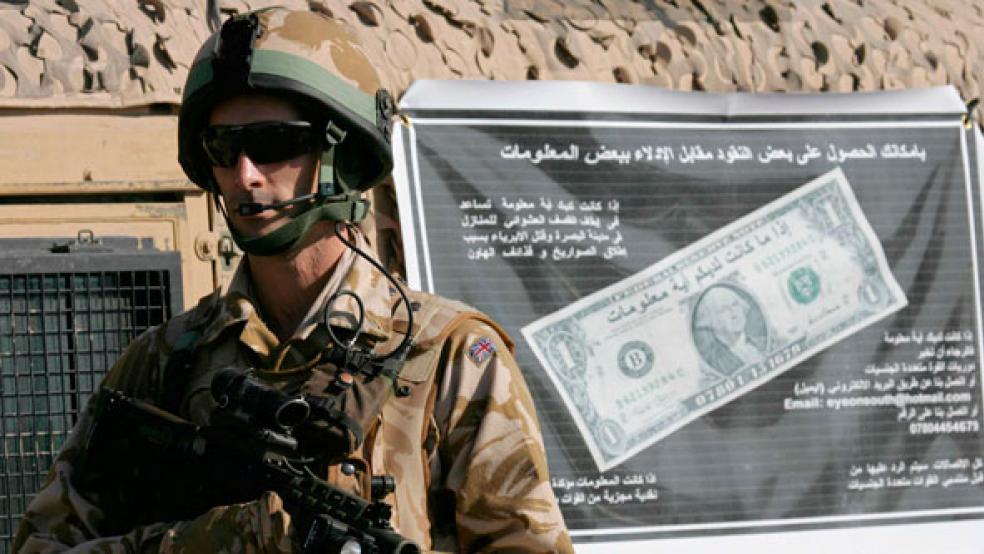In numerous speeches, President Obama has tried to sell Americans on the idea that the peace dividend, or the amount saved by ending wars and cutting the Defense Department budget, would invigorate the American economy.
In his speech at the Democratic National Convention in Charlotte last year, Obama said the hundreds of billions of dollars spent to fight in Iraq and Afghanistan would now be used to rebuild American infrastructure and create new jobs. He’s repeated similar claims in speeches he’s made since the convention.
“I'll use the money we're no longer spending on war to pay down our debt and put more people back to work — rebuilding roads and bridges, schools and runways,” Obama said last September. “After two wars that have cost us thousands of lives and over a trillion dollars, it's time to do some nation-building right here at home.”
President George H.W. Bush and British Prime Minister Margaret Thatcher first used the term peace dividend at the end of the Cold War, when the fall of the Berlin Wall allowed each nation to concentrate on making butter, not guns. In the United States, the dividend paid off, as the economy roared back in the late 1990s.
BUDGETARY SLIGHT OF HAND
The peace dividend anticipated from the most recent U.S. wars will be hard to find because of the way money was spent in Iraq and Afghanistan, and how the military is structured, experts say. Just because money is not being spent by the Pentagon does not mean that it can be spent by other agencies to create jobs or improve infrastructure.
“You can’t look at it from the point of view of the United States having more to spend,” said Jacob Stokes, a research associate at the Center for New American Security. “That’s just not true.”
It’s accurate to say that defense spending is going to be cut by nearly $500 billion in the coming years. But the money being cut did not originally come out of a U.S. savings account. The vast majority of what we spent to finance Iraq and Afghanistan was borrowed.
So unless the White House plans to continue to borrow money at the clip it did to finance two wars, there won’t be any new money to fund the infrastructure programs Obama is touting.
According to Linda Bilmes, a professor at Harvard’s Kennedy School of Government, some of the planned cuts simply will not be able to occur.
“THE PEACE DIVIDEND WON’T MATERIALIZE”
“We’ve made so many decisions over the last 10 years that have made structural changes in the defense budget,” she said. Costs related to those decisions are “rising very fast and will continue to grow so rapidly that the peace dividend won’t materialize.”
Military leaders told a Congressional subcommittee Tuesday that the spending cuts would put the country at risk because the Pentagon would be unable to combat all threats. But according to Bilmes, the areas where the Pentagon is most stressed deal with soldier benefits and deferred maintenance, not weapons systems or troop readiness.
It used to be, “join the Army and get a college education.” Now, it’s “get a deal on health insurance.” The cost of Tricare, DOD’s health plan, is expected to rise dramatically in the coming years. In 2001, military healthcare spending accounted for just $19 billion. By 2012 that number had increased to $52.2 billion. A report by the Center for American Progress estimates that the Pentagon will spend $63.9 billion by 2015.

These expenditures are occurring as Tricare’s insurance rates for retired military families have increased annually from $600 to $820. For enlisted men and women, annual fees increase from $230 to $269.28 for individuals, and to from $460 for $538.56 families. Given these dirt-cheap rates, it’s no surprise that the number of people the Defense Department insures is increasing.
“We saw Tricare membership accelerating as the Obamacare mandates kick in,” she said. Soldiers and their families “will take up Tricare as it turns out to be cheaper than getting health care through the open market or through state plans.”
CONGRESS HITS THE PAY WALL
There are also costs related to soldier pay. In 2004 and 2005, the Bush administration adjusted military pay scales higher as part of an effort to increase recruiting. The Congressional Budget Office found that military pay outpaced the income growth in the private sector by more than 25 percent in the last ten years. Because Congress approved these increases, lawmakers must repeal them as well.
“The Pentagon has tried to get [the pay increases] rolled back but Congress has not been willing and is unlikely to be willing,” she said.
Bilmes also said there is growing pressure to provide long-term care for war veterans that serve less than the 20 years required to receive health care as part of a retirement plan.
“There’s a lot of pressure to change the structure of the pension plan so that it benefits Afghan and Iraq vets,” she said. “This will add another layer of cost.”
Lastly, there are costs related to maintenance. Equipment used in the war needs to be repaired or replaced. Until this equipment is evaluated, there is no way to estimate how much this will cost.
Stokes added that there are procurement requirements looming. Many of the weapons used to fight in Iraq and Afghanistan are relics of the Reagan era, and will need to be replaced. And as the F-35 fighter program proves, acquiring new weapons can be a costly experience that lasts for decades.
“Too much of a peace dividend means you’re not investing in the future technologies that you need,” he said. “At the same time, if you do the spending cuts the right way, you can do it in a way that keeps the country safe.”





